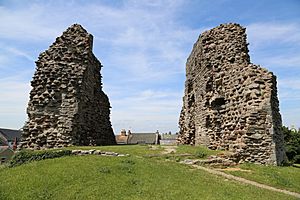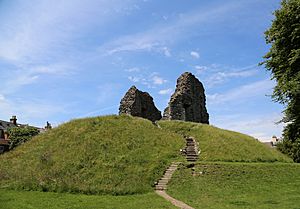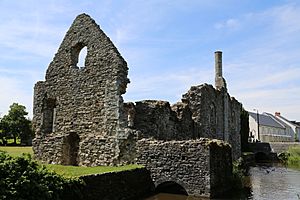Christchurch Castle facts for kids
Christchurch Castle is an old castle found in Christchurch, Dorset, England. It was built by the Normans, with the oldest stone parts dating back to about 1160. This castle is a type called a motte and bailey castle. This means it had a big mound (the motte) with a tower and a walled area (the bailey).
The castle was built inside an old Saxon town called a burh. It was important because it watched over the lowest crossing point of the River Avon. Right next to the castle is the Constable's House, also built around 1160. It's a special example of a Norman home. Today, the castle grounds have gardens and a bowling green. Parts of the main tower, called the keep, and the Constable's House are still standing. English Heritage looks after the site.
Contents
What is Christchurch Castle?
Christchurch Castle is thought to be built on the site of an even older wooden fort. This fort was likely built in 924. King Edward the Elder later added a motte (a large earth mound) to strengthen it.
After the Normans took over England in 1066, they made the castle's defenses stronger. They added a ditch and a bailey (a protected courtyard). These were surrounded by a wooden palisade (a fence of strong wooden stakes). Eventually, the wooden fort was replaced with a stone keep, which was the main tower.
Why was the castle important?
The Norman castle was a key defensive building. It was first controlled by the King's constable. Later, King Henry I (who ruled from 1100 to 1135) gave it to his cousin, Richard de Redvers. This made it the main castle of a feudal barony, which was a large area of land controlled by a powerful lord.
While Saxon forts protected against threats like Viking raiders, the Norman castle helped control the local people. It was also a good base for enforcing the strict rules of the New Forest. The castle controlled the harbor and access to the land through the Rivers Avon and Stour.
Castle's history and battles
The oldest stone parts of the castle date back to around 1160. There are also old papers showing the castle existed around 1130. Richard de Redvers is often said to be the first builder of the stone castle.
The castle was rebuilt by Baldwin de Redvers in 1147. This was to help him fight against King Stephen during a civil war with the Empress Matilda. A large tower was probably added around 1300.
The castle saw more action during the Civil War (1642–1651). In 1644, the Parliamentarians took control of the castle. The Royalists tried to capture it for three days. They even knocked down houses to set up their cannons! But the Royalists couldn't take the castle.
Oliver Cromwell, a powerful leader of the Parliamentarians, worried about such a strong castle. So, in 1652, he ordered it to be slighted. This means parts of it were deliberately destroyed so it couldn't be used as a fort again. Today, the castle is mostly in ruins. Only a few walls of the keep and parts of the rectangular moat remain.
The Constable's House
Near the castle is a special Norman home called the Constable's House. It was built inside the castle's original bailey (courtyard) in 1160. Much of its stone structure is still standing.
One cool feature is a rare Norman chimney. It's one of only five like it in England! The house was built using Purbeck marble, a type of stone.
The ground floor had four narrow windows and was used for storage. The upper floor was the main hall. You could reach it by outside steps or an inside staircase. It was about 67 feet long and 23 feet wide. Another interesting part is the garderobe tower. This was like an old toilet, built in the early 1200s. It extended over the mill stream to help with hygiene.
Protecting History
Both Christchurch Castle and the Constable's House are very important historical buildings. They are listed as "Grade I listed buildings." This means they are of exceptional historical interest. The whole area, including the nearby priory, the castle, and the Constable's House, is also a "Scheduled Monument." This gives it extra protection to preserve its history.




